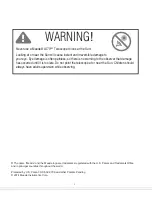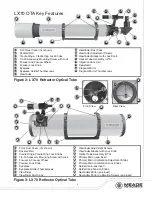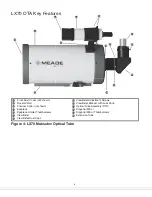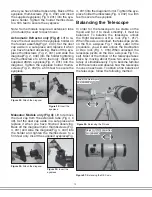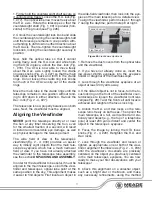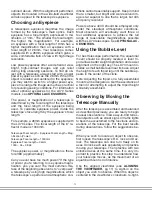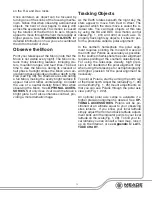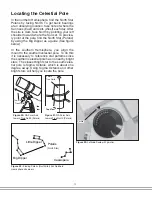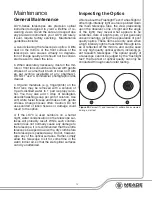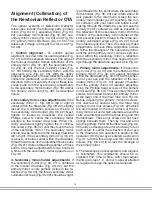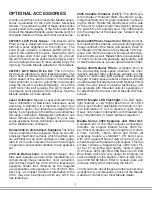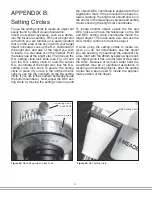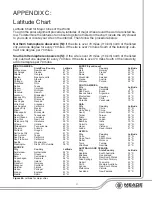
12
12
outlined above. With this alignment performed,
objects first located in the wide-field viewfinder
will also appear in the telescope’s eyepiece.
Choosing an Eyepiece
A telescope’s eyepiece magnifies the image
formed by the telescope’s main optics. Each
eyepiece has a focal length, expressed in mil-
limeters, or “mm.” The smaller the focal length,
the higher the magnification. For example,
an eyepiece with a focal length of 9mm has a
higher magnification than an eyepiece with a
focal length of 26mm. Your telescope comes
supplied with a 26mm eyepiece which gives a
wide, comfortable field of view with high image
resolution.
Low power eyepieces offer a wide field of view,
bright, high-contrast images, and eye relief
during long observing sessions. To find an ob-
ject with a telescope, always start with a lower
power eyepiece such as the 26mm. When the
object is located and centered in the eyepiece,
you may wish to switch to a higher power eye-
piece to enlarge the image as much as practical
for prevailing seeing conditions. For information
about optional eyepieces for the LX70 Series
models, see
OPTIONAL ACCESSORIES.
The power, or magnification of a telescope is
determined by the focal length of the telescope
and the focal length of the eyepiece being
used. To calculate eyepiece power, divide the
telescope’s focal length by the eyepiece’s focal
length.
For example, a 26mm eyepiece is supplied with
the LX70 series. The focal length of the 8” re-
flector model is 1000mm.
Telescope Focal Length ÷ Eyepiece Focal Length = Mag-
nification (Power)
Telescope Focal Length = 1000mm
Eyepiece Focal Length = 26mm
1000 ÷ 26 = 38.46
The eyepiece power, or magnification is there-
fore 38X (approximately).
Can you ever have too much power? If the type
of power you’re referring to is eyepiece magni-
fication, yes, you can! The most common mis-
take of the beginning observer is to “overpower”
a telescope by using high magnifications which
the telescope’s aperture and atmospheric con-
ditions cannot reasonably support. Keep in mind
that a smaller, but bright and well-resolved im-
age is far superior to one that is larger, but dim
and poorly resolved.
Powers above 400X should be employed only
under the steadiest atmospheric conditions.
Most observers will eventually want three or
four additional eyepieces to achieve the full
range of reasonable magnifications possible
with the LX70 telescopes. See
OPTIONAL AC-
CESSORIES.
Using the Bubble Level
For best telescope performance, the equatorial
mount should be properly leveled. A level tri-
pod allows better weight distribution and easier
alignment on the night sky. The LX70 mount in-
cludes a small bubble level near its base. Adjust
the height of each tripod leg until the bubble ap-
pears in the center of the circle.
Note: Adjusting the tripod on a fully assembled
mount can be dangerous. Get the assistance of
a friend if attempting to adjust the tripod height
while fully assembled.
Observing by Moving the
Telescope Manually
After the telescope is assembled and balanced
as described previously, you are ready to begin
manual observations. View easy-to-find terres-
trial objects such as street signs or traffic lights
to become accustomed to the functions and op-
erations of the telescope. For the best results
during observations, follow the suggestions be-
low:
When you wish to locate an object to observe,
first loosen the telescope’s R.A. lock and Dec.
lock. The telescope can now turn freely on its
axes. Unlock each axis separately and practice
moving your telescope. Then practice with two
unlocked axes at the same time. It is very im-
portant to practice this step to understand how
your telescope moves, as the movement of an
equatorial mount is not intuitive.
Use the aligned viewfinder (see
ALIGNING
THE VIEWFINDER,
pg 11) to sight-in on the
object you wish to observe. When the object is
centered in the viewfinder’s crosshairs, re-tight-
Summary of Contents for LX70 Series
Page 1: ...1 Instruction Manual LX70 Series German Equatorial Telescopes...
Page 25: ...25 OBSERVATION LOG...
Page 26: ...26 26 OBSERVATION LOG...
Page 27: ...27 OBSERVATION LOG...


